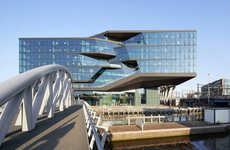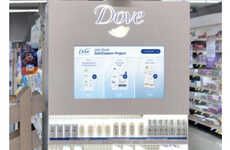
The New Unilver HQ Employs an Array of Sensors For Employee Health
Justin Lam — May 29, 2018 — Art & Design
References: roi-nj & fastcompany
Employees at the new Unilever HQ now have the ability to control the temperature, lights and general environment all through their personal smartphones. The new technologically driven space is just one part of the consumer giant's new office park and the brand's plan to be carbon positive by 2030. This ecological focus is further bolstered by the decision to swap out old inefficient windows and lights, as well as installing solar panels on the roof.
The technological elements of the new Unilever HQ come thanks to OVG, a Dutch developer, and the installation of 15,000 sensors across the 325,000 square foot space. These sensors measure temperature, light, carbon dioxide, humidity and presence throughout the building. The ability to measure human presence in the building is one of the most efficient applications of the sensors as it can allow the company to shut down whole floors when there is no one present in them.
Image Credit: Albert Vecerka-Esto/OVG/Unilver
The technological elements of the new Unilever HQ come thanks to OVG, a Dutch developer, and the installation of 15,000 sensors across the 325,000 square foot space. These sensors measure temperature, light, carbon dioxide, humidity and presence throughout the building. The ability to measure human presence in the building is one of the most efficient applications of the sensors as it can allow the company to shut down whole floors when there is no one present in them.
Image Credit: Albert Vecerka-Esto/OVG/Unilver
Trend Themes
1. Smart Building Technology - The integration of sensors and personal smartphone control in the new Unilever HQ showcases the trend in smart building technology, allowing for enhanced employee experience and energy efficiency.
2. Environmental Sustainability - Unilever's commitment to becoming carbon positive by 2030 is a trend that highlights the importance of environmental sustainability in the corporate world, encouraging other companies to adopt similar goals.
3. Occupancy Optimization - The use of sensors to measure human presence in the building and adjust energy usage accordingly presents a disruptive innovation opportunity for optimizing occupancy and energy efficiency in various industries.
Industry Implications
1. Real Estate - The integration of smart building technology in the new Unilever HQ opens up opportunities for real estate developers and property managers to create more advanced and sustainable office spaces.
2. Technology - The development and implementation of sensors and smartphone control systems in building infrastructure present new prospects for technology companies specializing in smart home/building solutions.
3. Energy - The focus on energy efficiency and renewable power sources, such as solar panels, in the new Unilever HQ drives innovation opportunities for the energy industry to develop sustainable solutions for corporate buildings.
4.7
Score
Popularity
Activity
Freshness























